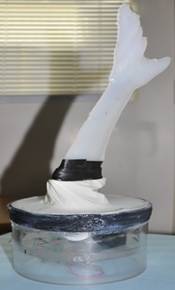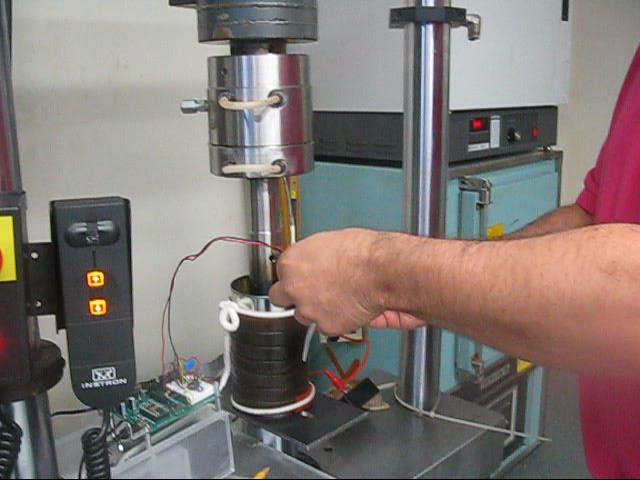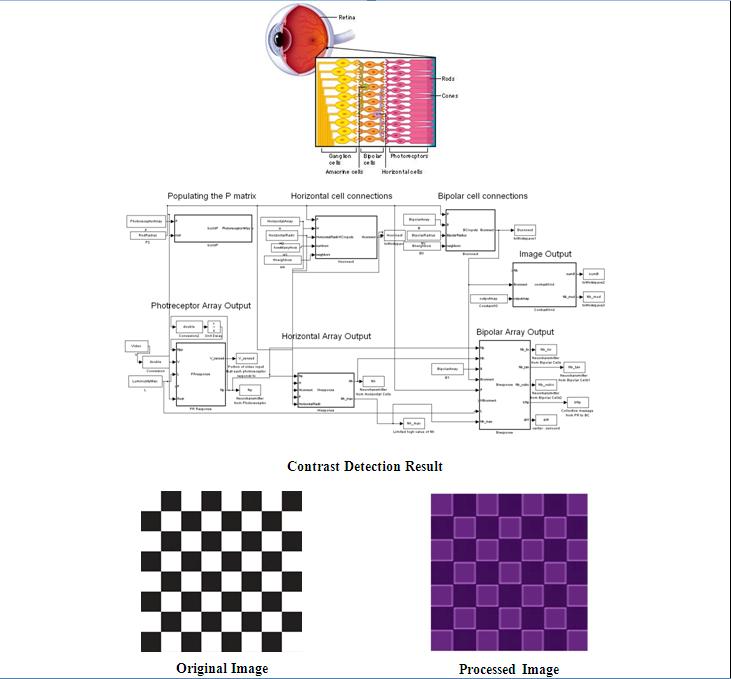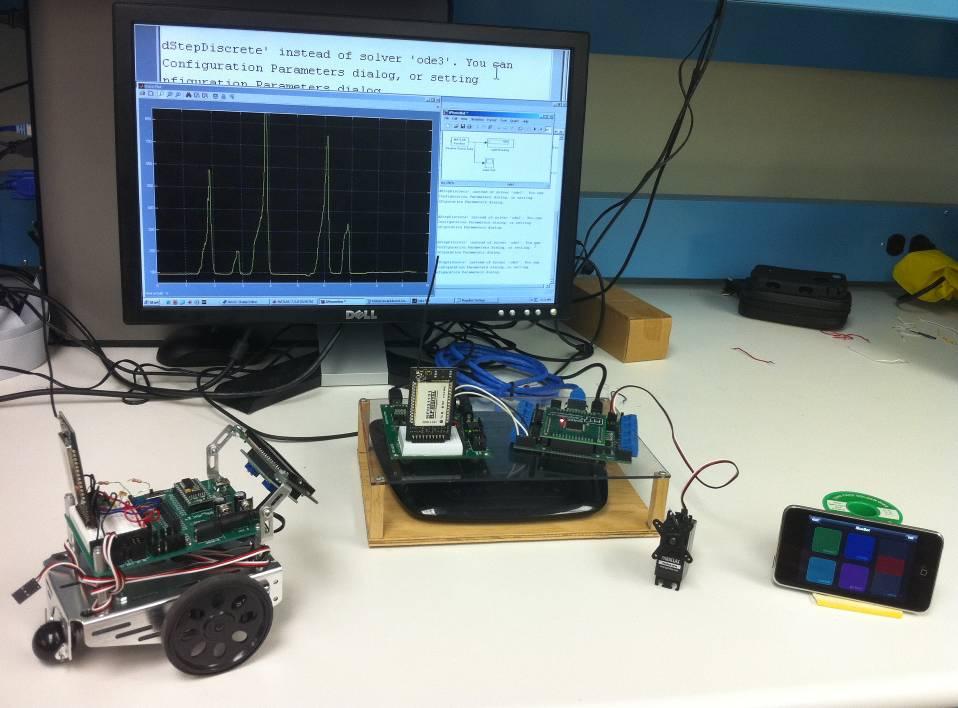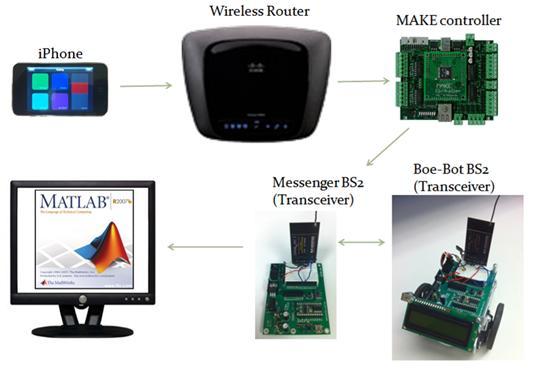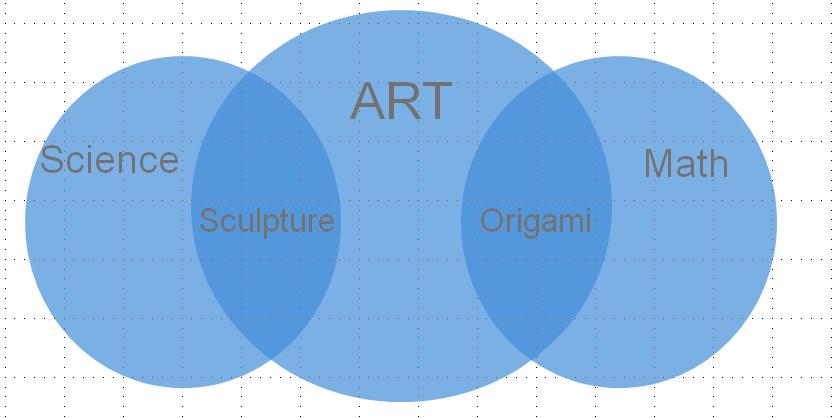2010 SMARTER Program Project Archive
Project 1: Development and Testing of a Sub-Carangiform Biomechanical Fish to Mimic Thresher Shark (Alopias sp.) Locomotion
Horace E. Walcott and Russell J. Holstein
|Presentation Slides | Lesson Plan | Poster |
Research
Title:Development and Testing of a Sub-Carangiform Biomechanical Fish to Mimic Thresher Shark (Alopias sp.) Locomotion
This research explored the morphology and physiology of the thresher shark, Alopias sp., a fish that employs sub-carangiform locomotion. The information gathered during this research facilitated the development of a biomimetic robotic fish tail. A slender beam encased in a silicone polymer mold, geometrically similar to the thresher shark’s anatomy, was mechanically oscillated to produce sub-carangiform locomotion. The oscillations were induced using an attached servomotor, which was controlled by a BASIC Stamp microcontroller. Tests conducted in an aquarium tank indicated that a transparent plastic beam had the required modulus of elasticity for insertion into a biomimetic tail. A 3D model of the tail was designed using Solid Works. The mold for the silicone tail was also designed using Solid Works, and was created using a computer numerical control (CNC) machine with ShopBot software. After curing, the tail’s motion was studied using image analysis. The tail design was based on morphometric data of thresher sharks.
Lesson Plan
Title: Solar Hydrogen Electric Robots
Students will learn about the structure and function of a solar hydrogen electric (sHe) car by studying the simple mechanism of hydrogen and oxygen production from the electrolysis of water in a fuel cell, as well as the photoelectric and photovoltaic effects. Working in teams of three to four, students will design and build robots using Parallax BOE-Bot kits and install a sHe kit on the robots. Two fuel cells will be connected in series with two solar panels. The robot will be programmed to autonomously drive 100 meters down a hallway and return to its starting position. Students will record the volumes of hydrogen and oxygen consumed, as well as the voltage and current of the fuel cell unit. This lesson will introduce to students concepts of energy, including the different forms, different methods of generation and transfer, and other related scientific concepts. Illustration of these concepts through real-world robotics hardware and software will demonstrate to students the interplay between science and engineering.
Project 2: Split-Hopkinson Pressure Bar Dynamic Compressive System
Jozef Pistek and Greg Sciame
|Presentation Slides | Lesson Plan | Poster |
Research
Title: Analysis of PVC Foam and Carbon Nanofiber Syntactic Foam
Composite materials are now widely used in daily life and they undergo high loading rate deformations in many of their current applications. Although mechanical characteristics of materials are known to be dependent on their loading rate, the high strain rate properties and dynamic failure mechanisms of composites are not well understood. This research used in-house developed advanced instrumentation, called Hopkinson bar, to develop such knowledge about emerging composite materials. Both traditional static and high strain rate compression tests were conducted on samples of Polyvinyl Chloride (PVC) foam as well as on samples of syntactic foam that contain glass microballoons of varying densities in different volumes as well as 1% carbon nanofibers (CNF).
In static compression tests, the PVC foam samples displayed an increase in every compressive property (yield strength, plateau strength, and elastic modulus) as their density increased, while the trends displayed by CNF syntactic foam samples were complex and depended on the volume fraction and density of microballoons used in the specimen. In the high strain rate testing using Hopkinson bar, the lowest density PVC foam displayed the highest specific modulus, while the syntactic foam containing high density microballoons in high volume fraction displayed the highest specific yield strength. The study demonstrates strain rate dependence of mechanical properties of porous materials and illustrates the need to account for the strain rate in the design criteria for a structure utilizing foams.
Lesson Plan
Title: Electricity and Electric Circuits
This lesson will expose students to the concepts of electricity and electric circuits. They will learn the physics behind some circuits, the key components in a circuit, and the ubiquity of electric circuits in our everyday lives. Students will learn about Ohm's Law, electrical power and energy, and various techniques to analyze electrical circuits. After this lesson, students will be able to:
• Define electric current and voltage
• Explain the relationship between voltage, current, and resistance (Ohm's Law)
• Understand electric power and energy
• List several different circuit components (resistors, capacitors, inductors, etc.)
Project 3: TCI Apparatus for Creep Behavior of Recycled HDPE Using Stepped Isothermal Method
Toufik Ayoub and Marcia Moore
|Presentation Slides | Lesson Plan | Poster |
Research
Title: TCI Apparatus for Creep Behavior of Recycled HDPE Using Stepped Isothermal Method
This research is concerned with the compressive creep behavior of High Density Polyethylene (HDPE), a viscoelastic material commonly used to manufacture polymeric piling, decking, and fender elements. In this research, we developed a temperature control instrument (TCI), an experimental apparatus to control the temperature of a specimen as it is mechanically compressed. This apparatus facilitates examination of the effect of combined temperature cycles and different loading rates on the durability of recycled HDPE specimen bars. Through a series of cyclic temperature variations, we collected experimental data and analyzed it to obtain conclusions about the material’s strength under different loading rates and at different temperatures. The Stepped Isothermal Method (SIM) has been adapted to study the time and temperature dependent compressive creep of HDPE.
Lesson Plan
Title:Climographs
A climograph is a graphical method of displaying climate information–specifically the average temperature and precipitation–at a particular location. In addition to being a valuable tool in studying climate, climograph can also be used to infer connections between climate and human conditions. In this lesson, students will learn about how to read, analyze, and construct climographs. They will practice associating climographs to different locations in the United States and in Africa. Moreover, they will learn to discern climate patterns and investigate links between climate patterns and human conditions in different places in Africa.
Project 4: MATLAB Modeling of Retina Structure and Function
Jason Farina
|Presentation Slides | Lesson Plan | Poster |
Research
Title: MATLAB Modeling of Retina Structure and Function
Research at the intersection of neuroscience and engineering offers the promise of neuro-mechanical prostheses. The success of cochlear implants and interest in brain function, robotics, and quality of life issues has motivated a search for an ocular prosthesis. Recently retinal implants have successfully offered low-resolution sight to the blind, but an incomplete understanding of the structure and function of the retina is preventing a prosthesis from “plugging” into the optic nerve. In this research, we used our current knowledge of retina anatomy to develop a MATLAB/SIMULINK model that mimics the structure and function of the retina. Preliminary simulation efforts reveal that our anatomically correct MATLAB/SIMULINK model is effective in detecting contrast. Validating the MATLAB simulation model with clinical data can support the accuracy of our current understanding of the structure and function of the retina. Moreover, our MATLAB simulation approach can allow us to test alternative hypotheses of structure and function of the retina, which will motivate new clinical investigations. Finally, new clinical knowledge will lead to better simulation models. Interplay and synergy between the modeling and clinical approaches can potentially accelerate and enhance our understanding of how the eye processes images of our physical world.
Lesson Plan
Title: Building the Haystack and Finding the Needle: Creating and Searching Matrices
Matrices are a useful and powerful way to organize and manipulate numbers and are used in a variety of engineering contexts. MATLAB is a popular mathematical software package that is built on matrix math. In this lesson, students will use MATLAB to learn to create algorithms that populate matrices with numbers that meet specified criteria. They will also learn to search matrices and pull out desired information. Following this lesson, students will • Understand how matrix indices are used to move through a matrix • Practice developing algorithms to automate the solution to a mathematical problem • Practice testing and revising computer instructions that implement a specific algorithm
Project 5: iPhone-Controlled Robotic Project
Matthew Fisher and Vanessa Geraldi
|Presentation Slides | Lesson Plan | Poster|
Research
Title: iPhone-Controlled Robotics Project
This effort focused on building and exploring a mechatronic project that can be remotely controlled using the iPod or iPhone mobile devices. Whereas on-going iPhone-controlled projects in the lab (e.g., iPhone-controlled Create robot, Smart-House, and RC-Truck) involve physically mounting a router and a MAKE microcontroller on the project, our platform separates the router and the MAKE microcontroller from the mobile platform, thus reducing its overall weight. Specifically, our effort resulted in the development of a platform wherein: (1) a remote user interacts with a graphical user interface on a mobile device to send control commands over a Wi-Fi netwrok; (2) a MAKE microcontroller interfaced to a wireless router receives the remote user’s control commands over the Wi-Fi network; (3) the MAKE microcontroller serially communicates the control commands to a Basic Stamp microcontroller; (4) the Basic Stamp microcontroller transmits the control commands to a mobile robot using an RF-transceiver, receives sensory data from the robot using the RF-transceiver, and serially communicates the received sensory data to a Matlab program running on a PC; and (5) a MATLAB program stores, display, and plots the received sensory data, which can be analyzed in real-time and used to make new control decisions. In on-going effort, we will eliminate the Basic Stamp microcontroller and serially interface the RF-transceiver and MATLAB directly to the MAKE microcontroller. Moreover, we plan on replacing the role of MATLAB with an iPhone application so that the sensory data can be stored and displayed on the iPhone itself. This research involved all principles of robotic systems, including mechanical and electrical subsystem design, hardware interfacing, and programming.
Lesson Plan
Title: Isotherm Maps
This lesson is a collaborative effort between a Technology Education class and a regents Earth Science class. The technology students will be responsible for building and programming a mobile robot that is equipped with a temperature sensor, radio-transceiver, and the capability to display sensor readings. Once the robot is completely built and tested, the Earth science students will use the robot to take multiple temperature measurements in the classroom. The classroom will incorporate fans and heaters to produce a non-uniform temperature environment. Students will use the measurements to connect points of equal temperature to produce an isotherm map.
Project 6: Stochastic Surface Effects on Nanobeam Behavior
Robert Jim Calungsod
|Presentation Slides | Lesson Plan | Poster |
Research
Title: Stochastic Surface Effects on Nanobeam Behavior
The turn of the century brought forth an invigorated pursuit to conquer the nanotechnological world. With the advent of highly powerful tools in microscopy and subatomic probes, the utilization of novel particles and nanosructures has led to a wide variety of research and applications ranging from medicine, robotics, supercomputing, physics and the like. This effort focused on examining the stochastic behavior on the effective properties of nanowires. Under Prof. Dingreville’s guidance, we reviewed the prior literature to understand the scientific background and underlying theories. Next, using a perturbation method, we initiated the development of a new formulation for the study of nanowire manufacturing. While our initial effort has focused on the surface effects in nanobeam behavior, we conducted another parallel study to account for the buckling effect of the material itself.
Lesson Plan
Title: Stochasticity and Probability
The teaching of stochasticity and stochastic processes as a probabilistic principle has been largely disregarded and abandoned because it is considered synonymous to probability theories. This lesson will introduce to students stochastic processes and allow them to examine its similarities and differences vis-à-vis probabilistic processes by comparing and contrasting their properties. Simulations will be the main tool to answer probability and stochasticity questions. After this lesson, students should be able to: 1. Compare and contrast: stochastic processes versus random processes 2. Solve real-world problems involving stochasticity 3. Implement their own stochastic process by completing the assignment
Project 7: Art as an Integrator for Research, Education, and Outreach
Donna Gobin
|Presentation Slides | Lesson Plan | Poster |
Research
Title: Art as an Integrator for Research, Education, and Outreach
AKnowledge can be obtained in multiple ways. Traditionally art classes are thought to be hands-on with an open environment that promotes creativity. In contrast, math and science classrooms are thought to be restrictive with little to no room for creativity. It has been proven that when students are more involved in classrooms they connect better with their field of study. In this effort, we are exploring the use of art as a vehicle to transmit STEM knowledge to students. Specifically, this informal approach is being investigated to introduce to students fundamental concepts in materials science, mechanical engineering, and mathematics. Our main goals are: • Establish an interdisciplinary collaborative team consisting of NYU-Poly researchers, NYC school teachers and students, and local artists • Spread scientific and artistic literacy • Infuse and stimulate knowledge, skills, creativity, versatility and a sense of wonder among youngsters • Integrate scientific activities into artistic creations and vice-versa • Broaden the ties of NYC-Poly with local community In on-going effort, we plan to develop “art objects,” and hold exhibits that illustrate the use of various materials used in art.
Lesson Plan
Title: Transformations and Sculpture
Demos and activities in this lesson are intended to illustrate the basic concepts of transformation geometry-translations, dilations, rotations, reflections, and tessellations. The students will learn the techniques necessary to perform transformations and create a sculpture during the course of this program. Students will gain following math knowledge: basic geometric properties of 2D and 3D figures; representing patterns and simple relationships; and identifying the results of transformations on plane figures. Moreover, students will gain following art knowledge: classifying art pieces into periods, such as cubism; recognizing artwork of famous artists; considering limitations and advantages of certain materials; and exposure to art museums and galleries. Finally, students will gain following science knowledge: introduction to material science; understanding of basic material properties (metal, ceramic, wood); conducting materials oriented laboratory experiments; exposure to molecular views of materials; and learning science through ideas not formulas. The completion of a sculpture and a quiz will be used to reinforce and assess the basic math, art, and science concepts.
